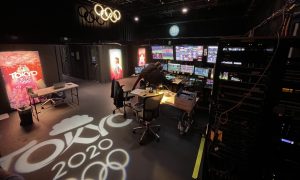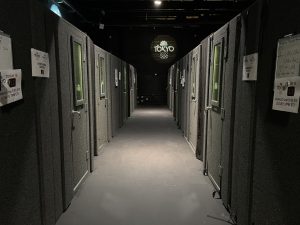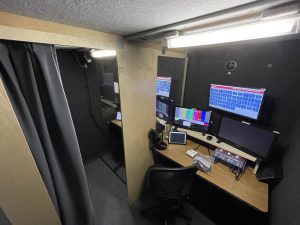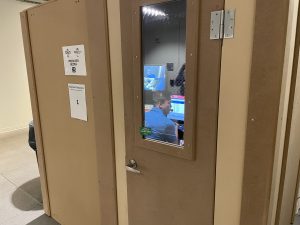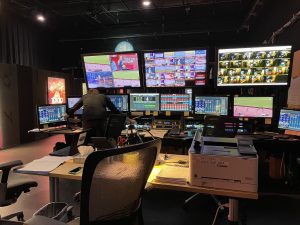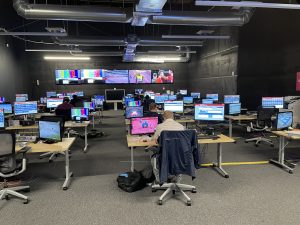NBC Stamford Spotlight, Part 3: Inside the ‘Off-Tube Factory’ Remote Commentary Workflow
The setup consists of 28 announce booths
When the COVID-19 pandemic shut down the U.S., sports networks audibled and kept on-air talent away from the venue. This is customary for an international event like the Olympics, but the decision also satisfied safety concerns and streamlined operations. In Stamford, NBC Sports developed the largest iteration of its Off-Tube Factory to add remote commentary to the XXXII Olympiad.
“[The Off-Tube Factory] at one point was one person, but now we have two shifts of two people [who run this] 24 hours a day,” says Tim Canary, VP, engineering, NBC Sports Group. “This is all coordinated with [CVT Supervisor/Director] Kaare Numme, Gino Tanasescu, and the EVS team, so they’ll make sure that the feeds are routed and go through the testing process ahead of the event.”
More NBC Spotlight:
- Part 1: Stateside Olympics Effort Deploys Army of Studios, Control Rooms, Trucks, ‘Family & Friends’ Unit
- Part 2: Extra Year of Prep Boosts NBC Olympics’ At-Home Operation.
To handle the profusion of shows and analysis, the studio-operations team works closely with Senior Manager, Production Engineering, Gary Bartunek and his crew during each day’s events. The broadcaster transformed Studio 4 into the epicenter of the effort with a mini BOC (Broadcast Operations Center) manned 24 hours a day by two staffers.
All video signals are routed into 28 booths controlled in Stamford. Twenty-five announce booths (11 in Studio 4,
nine in Studio 5, four in PCR1, one in PCR8) and a producer-only booth, which communicates with the commentators onsite in Tokyo, are in Stamford. Two announce booths are located at Telemundo’s facility in Miami.
Each commentary pod in Stamford comprises a play-by-play announcer, a color commentator, and a dedicated producer. Because of the ongoing pandemic, a wall separates the announcers, who are located next to each other;
the producer works on the opposite side of another wall. To troubleshoot audio issues, the Off-Tube
Factory uses four roaming A2s, who monitor each feed and announcer levels and also help the announcers with headsets/boxes and the producer with comms.
On the announcers’ end, each talent receives a world feed from OBS, a video feed from the corresponding Stamford-based control room, a mixed-zone feed for specific sports, and a CIS (Connectivity Information System) computer for real-time data. The producers’ section of the booth provides communication with the talent, the production-control room, statistician, and the individual working in the central tape area.
Given the simultaneous nature of the Olympics, the announcers come from different networks to provide their expertise. Some of the 50 Olympics events are being called by high-profile industry names: for example, Jason Benetti and Eduardo Perez on baseball, Fran Fraschilla and Monica McNutt on basketball, Kenny Albert on beach/indoor volleyball, Noah Eagle on 3×3 basketball, and Beth Mowins on softball. The audio side has been
worked out from every angle, including a workflow that streamlines commentary for both HDR and SDR productions.
“We’re using some of the processing paths for what we call ‘virtual’ booths,” says Canary. “If we’re calling something in 1080i, we can also route the video through a Lawo [V_pro8 video processor] so it can be done in 1080p HDR at the same time, with audio copied to both versions via MADI.”
Since the Stamford facility is massive, the operations team is finding ways to utilize empty spaces and unused rooms. Studio 4 is one example, but PCR5 is also being used as an extension of the Off-Tube Factory.
Statisticians are assigned to a booth for the duration of the sport’s broadcast. At their desk, all statisticians have an output monitor of the booth, communications with talent and producer, a CIS computer for stats, and space for an
additional computer. In response to health and safety protocols, the Hawk-Eye system is being used to feed research and data from the statisticians to an iPad in the announce booth.
Delivering the Tokyo Games to the masses is an impressive feat, but NBC Sports developed this plan as well for the 2022 Beijing Winter Olympics just six months away and for the upcoming season of Sunday Night Football. The infrastructure has come a long way since its first iteration in 2008, and it will continue to be the foundation of the network’s Olympics coverage moving forward.
“We started with 10 booths in 2008 for Beijing and then 18 booths in 2016 for Rio, and now we’re at 28 booths [for Tokyo],” says Canary. “We also left our SNF setup with a couple of Chyrons, because, in a week or so [after the Games], we’ll be doing a bootcamp with our graphics producers.”

